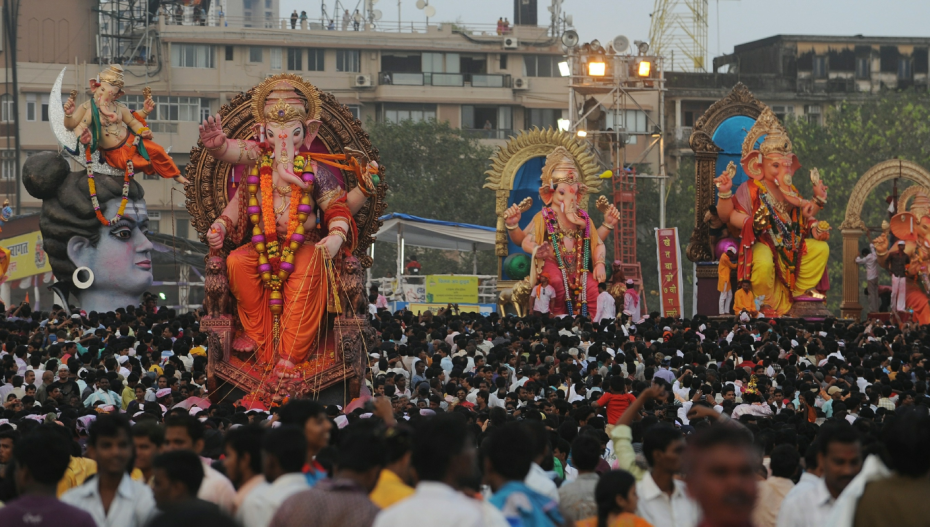Ganesh Chaturthi, also known as Ganeshotsav, is a ten-day festival marked by the installation of clay idols of Lord Ganesha in homes and elaborate pandals for communal festivities. On the tenth day, Anant Chaturdashi, the Visarjan ceremony takes place, during which the idol is publicly paraded with music and chants of “Ganpati Bappa Morya Pudhchya varshi lavkarya” (Return soon next year) before being immersed in a nearby water body.
In Maharashtra, especially Mumbai, Ganesh Chaturthi is eagerly awaited. Apart from the elaborate rituals at the Siddhi Vinayak temple in Prabhadevi, various mandals or associations across the city celebrate the festival by placing Lord Ganesha idols, accompanied by daily cultural programs.

Labaugcha Raja in Parel is one of the most revered idols, attracting people from across the state to witness the celebrations, including dances, bhajan singing, and cultural performances. In other areas, pandals with thematic representations of social issues are erected, adorned with vibrant decorations and aartis. Sweet shops offer a variety of modaks, Lord Ganesha’s favorite sweet. With the sound of the dhol and tasha drumming and chants of “Ganpati Bappa Morya” echoing through Mumbai, the ten-day Ganpati festival culminates in the Anant Chaturdashi visarjan procession from Lalbaug, which takes nearly 22 hours to reach Chowpatty.

In Goa, Ganesh Chaturthi is celebrated with grandeur. Homes ceremonially install clay murtis of Lord Ganesha beneath a matoli (a wooden canopy) adorned with flowers, seasonal vegetables, and fruits. In places like Panjim and Quepem, local mandals organize Sarvajanik Ganeshotsav with large idols placed in traditionally decorated pandals. People, dressed in traditional attire, visit these pandals, buy lucky draw tickets and participate in various competitions for the best decorated Ganesh, rangoli and fancy dress, spanning over ten days. Traditional sweets like nevri, ladoos, modaks and patoleo are distributed and enjoyed.

During the Peshwa rule in Maharashtra, the tradition of Sarvajanik Ganesh Utsav was introduced in Pune in 1892 by revolutionaries like Shrimant Bhausaheb Rangari and Vishwa Bhasavdekar. Ganpati pandals were set up across the city for everyone to view and participate in the rituals. This tradition continues with community celebrations held throughout Pune. The largest Ganpati idol in Tulshibaug Pune stands at 15ft and features a different theme each year. Dagdusheth Ganpati Mandir is a sought-after place for offering prayers, attracting visitors from across Maharashtra. Tambadi Jogeshwari and Kasba Ganpati Mandir are other popular destinations.

The Kasba Ganpati Mandir is the presiding deity in Pune city, also known as Gramdaivat. The visarjan ceremony in Pune is a vibrant sight, with women in nauvari saris and men and young boys in bright red or saffron kurtas. The highlight is the elaborate performance (vadan) using five instruments: dhol, tasha, tol, jhanj, dhvaj. The 131-year-old Shrimant Bhausaheb Rangari Ganpati idol, made of papier-mâché and sawdust, is placed on a traditional wooden chariot and pulled by bullocks during the procession, and finally, a smaller representative idol is immersed.

Karnataka’s Ganesh Chaturthi festival differs from other regions due to the Swarna Gouri Vratam or Gouri Habba preceding it, making it known as Ganesh Gouri Festival. The main street, Car Street, buzzes with excitement, and activities begin days in advance. Street vendors sell idols, flowers, moode leaves, and sugar cane, particularly near the popular Clock Tower. Music plays a significant role in the celebrations, with devotional songs (Bhaktigeetas) sung in various pandals accompanied by musical instruments and people gather for late evening gatherings.
In Bengaluru, the APS College Grounds in Basavanagudi hosts one of the most popular celebrations, spanning over five decades. The ten-day cultural extravaganza, known as the Bengaluru Ganesha Utsava, features performances by renowned musicians and is one of India’s largest cultural events.

Hyderabad is known for the Khairatabad Ganesh, one of the most well-known and visited Ganesh pandals. It features a towering 50ft Ganesh idol that attracts people from across the city.
The streets of Vijayawada come alive in the days leading to Ganesh Utsav, with people thronging stalls selling flowers, decorations, idols, and sweets in the Kaleswara Rao and Nunna Mango market areas. Over 3,000 pandals across the city celebrate Ganesh Chaturthi with fervor and enthusiasm.

Surat prepares annually for Ganesh Chaturthi celebrations, a tradition that began in 1942 when a Ganesh idol was installed in the Hindu Milan temple in Gopipura. The Surat Ganesh Utsav Samiti organizes a Ganesh arrival Yatra, and nearly 50,000 idols are installed across different areas in Surat. Mud idols, approximately 9ft tall, are commonly seen in most mandals.

In Nagpur, Ganpati mandals celebrate the festival with aarti singing and mantra chanting. The Vidarbha Mathadi Kamgaar Ganesh Utsav features a 31ft tall idol, drawing people from Nagpur. Cultural activities take place each evening, with the Futala lake area bustling on Visrajan day as thousands gather to bid farewell to Lord Ganesha. The Shri Ganesh Mandir Tekdi Nagpur is another popular place for the morning aarti.
Also Read: Cyber Crime Strikes Again; Man Loses Rs 9.7 Lakh In Sim Fraud













